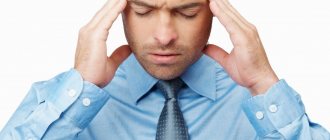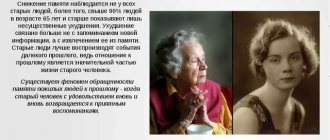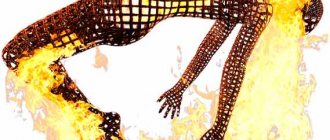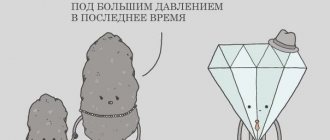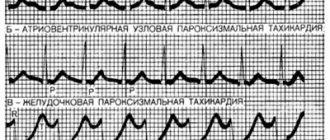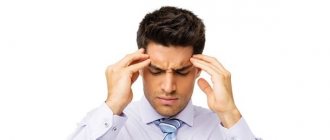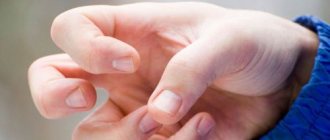Often, during light, shallow sleep, we can feel a sharp, nagging pain in the leg, severe numbness of the limb, and unpleasant tingling. Night cramps are a fairly common phenomenon that occurs in people of all ages. The reasons for their occurrence can be very different, from sudden overexertion, too intense sports, lack of certain vitamins and microelements in the body, to severe dehydration and even pinching of a nerve.
Symptoms and signs of vasospasm
Symptoms characteristic of almost all manifestations of vasospasm include headache, which is localized in the temples, eyes, forehead or back of the head with squeezing and pressing spasms. Gradually the pain spreads throughout the head. A person may also have signs of:
- noise in the ears and head;
- nausea or vomiting;
- dizziness;
- the appearance of spots in the eyes and darkening;
- disorientation or loss of consciousness;
- memory impairment;
- decreased performance and fatigue
The causes of vasospasm include diseases:
- Atherosclerotic changes in blood vessels.
The wall of the vessel consists of elastic fibers that compress and stretch well. With atherosclerosis, cholesterol plaques and salts are deposited in it, and this disrupts its structure.
- Osteochondrosis of the cervical spine.
The resulting spikes on the spine put pressure on the blood vessels and prevent the flow of blood. This leads to a reflex spasm.
- Diseases of the endocrine system associated with hormonal imbalances.
- Stress and overwork.
- Hemorrhages in the brain, during which the blood vessels, trying to stop the bleeding, narrow significantly.
- Cardiovascular diseases.
- Inflammation of the vascular walls - vasculitis.
- Brain tumors.
- Traumatic brain injuries.
Physical impairments and disorders.
The main factors for the appearance of cramps in the lower extremities, which indicate the root causes of convulsive muscle contractions, are:
- Suffered injuries of varying severity. At the same time, the patient feels a headache and general physical fatigue, fatigue sets in, and sweating increases.
- Diseases of the central nervous system. Progressive chronic diseases accompanied by severe disturbances in the functioning of the brain and peripheral nervous system (epilepsy, neuroses, tetanus, etc.).
- Vascular crises and dystonia (cerebral vasospasm). Prolonged spasm of blood vessels, resulting in a decrease in the lumen due to narrowing of their walls.
- Severe metabolic disorders and poisoning, when the body's loss of water and salt reserves can lead to convulsive muscle contractions, accompanied by pain in the arms and legs.
- Subarachnoid hemorrhage, in which there are complaints of the sudden appearance of blinding pain in the head.
- intracranial hypertension – increased intracranial pressure (ICP).
- meningitis (inflammation of the lining of the brain). The patient suffers from increasing pain, body hyperemia, photophobia, and stiffness of the neck muscles (rarely, pain in the legs).
- Fibromyalgia. They are characterized by chronic musculoskeletal symmetrical pain throughout the body, causing disturbances in the alternation of sleep and wakefulness phases. As a rule, no abnormalities can be diagnosed in patients with fibromyalgia. In most cases, doctors do not recognize such a diagnosis or clarify it by exclusion.
- ARVI and acute respiratory infections. Acute respiratory viral infections also become the culprits of headaches and seizures (with complications). The main reason for the occurrence of such symptoms is that the influenza virus wandering in the blood causes irritation of the cerebral cortex, which is responsible for controlled muscle contractions.
- suffered injuries of varying severity. At the same time, the patient feels a headache and general physical fatigue, fatigue sets in, and sweating increases.
- diseases of the central nervous system. Progressive chronic diseases accompanied by severe disturbances in the functioning of the brain and peripheral nervous system (epilepsy, neuroses, tetanus, etc.).
- vascular crises and dystonia (cerebral vasospasm). Prolonged spasm of blood vessels, resulting in a decrease in the lumen due to narrowing of their walls.
- severe metabolic disorders and poisoning, when the body's loss of water and salt reserves can lead to convulsive muscle contractions, accompanied by pain in the arms and legs.
- subarachnoid hemorrhage, in which there are complaints of the sudden appearance of blinding pain in the head.
- intracranial hypertension – increased intracranial pressure (ICP).
- meningitis (inflammation of the lining of the brain). The patient suffers from increasing pain, body hyperemia, photophobia, and stiffness of the neck muscles (rarely, pain in the legs).
- fibromyalgia. They are characterized by chronic musculoskeletal symmetrical pain throughout the body, causing disturbances in the alternation of sleep and wakefulness phases. As a rule, no abnormalities can be diagnosed in patients with fibromyalgia. In most cases, doctors do not recognize such a diagnosis or clarify it by exclusion.
- ARVI and acute respiratory infections. Acute respiratory viral infections also cause headaches and seizures (with complications). The main reason for the occurrence of such symptoms is that the influenza virus wandering in the blood causes irritation of the cerebral cortex, which is responsible for controlled muscle contractions.
As you can see, there is a clear relationship between headaches and leg cramps.
The phenomenon of vasospasm
Severe vasospasm
Narrowing of the heart artery leads to angina pectoris with characteristic long and severe attacks at rest. Severe vasospasm is characterized by pressing and cutting pain behind the sternum, which often appears early in the morning or at night when in a horizontal position. At this time, the cardiogram will show deviations when the coronary arteries are not blocked and there are no signs of oxygen starvation for the myocardium. This is often preceded by minor physical activity.
Moderate vasospasm
Moderate vasospasms of small and medium-sized vessels include spasms of the legs of the great vessels. This is characterized by the fact that the legs first turn pale, then turn blue, and then redness is observed. They are often tired and cold, lameness and pain appear.
Moderate retinal vasospasm is a slight narrowing of the caliber of the vessels that supply the eye. It is the result of general somatic disorders in the body.
Peripheral vasospasm
Peripheral vasospasm or vasospasm occurs most often and occurs against the background of vegetative-vascular dystonia and manifests itself in several varieties:
- spasms of the upper limbs;
- livedo reticularis is a disease that occurs in young girls and women. The affected area becomes bluish in color, and the skin around it turns pale. With hypothermia, the symptoms intensify, and disappear in the warm season;
- acrocyanosis is a disease that manifests itself during puberty and is accompanied by numbness of the limbs and increased sweating;
- for lung diseases and chronic heart failure;
- chills appear in cold weather in the form of bluish lumps on the face, hands, feet and behind the ears;
- Raynaud's syndrome is a spasm in which there are three phases: ischemia, cyanosis and hyperemia. In the first phase, small arteries spasm and the lumen of the capillaries narrows. In the second, blood stagnates in venules, arteriovenous anastomases and capillaries. During the third phase, the vessels dilate reactively. All this is accompanied by a violation of sensitivity.
Most often, peripheral vasospasm is associated with disturbances in the tone of capillaries located on the skin. They occur in the presence of negative factors: weather conditions, stressful situations, lifestyle changes.
Treatment methods
The doctor can choose the direction of treatment based on the established causes of vascular tinnitus. For example, these include the manifestation of oxygen starvation of the human brain.
This is why the patient experiences decreased blood flow. In turn, the cause of this phenomenon can be considered various vascular pathologies, which can be caused by vascular sclerosis. This disease is characterized by increased accumulation of cholesterol on the walls of capillaries.
For this reason, blood cannot circulate normally through the vessel and, as a result, a sufficient amount of oxygen does not reach the brain. Treatment of high cholesterol levels boils down to following a special diet and, if necessary, using medications that should be prescribed by a doctor.
If tinnitus is associated with blood vessels, then this may also be the first sign of an upcoming stroke. Brain cells gradually die, causing various painful symptoms, including tinnitus.
If you suspect a stroke, you must call an ambulance. Only in a hospital setting will qualified specialists be able to prevent a possible stroke.
People experiencing constant low blood pressure very often experience this symptom. Also, a sharp change in it can be a consequence of stress.
On this topic
Everything you need to know about noise in your head
The shock experienced causes improper blood circulation in the brain, and hence the characteristic ringing and pulsating sounds in the ears. There are diets and special medications that can normalize blood pressure.
Based on the identified causes, the doctor prescribes treatment. All therapy comes down to the complex administration of medications.
Drugs for treatment
When the fact of oxygen starvation of the human brain is established, the following drugs are prescribed to improve blood flow in the vessels:
- Actovegin - this drug improves tissue renewal and increases the speed of metabolic processes in the body. This medication is widely used for various disorders of brain function, as well as for its injuries and adaptation after them.
- Antisten - is prescribed as a drug that increases the metabolism of neural tissue in the brain.
- Vasobral is a well-proven remedy for activating nerve impulses in the brain.
- Gliastylin is a drug that improves blood circulation and metabolism.
- Capilar - a remedy used to strengthen the walls of blood vessels and relieve their inflammation. The advantage is that the drug is completely of plant origin. Made from larch.
- Neuromedin - restores muscle tissue and transmission of nerve impulses.
- Cerebrolysin - restores metabolic processes in brain tissue.
Angiospasm treatment
Treatment of angiospasm should begin with a thorough examination to identify the cause and select a treatment method. It is different for each patient. In many medical institutions, duplex scanning, Doppler ultrasound, ultrasound and measurement of oxygen tension through the skin are first prescribed. Spasms of the legs and arms are treated by applying a weak eclectic current. The course is designed for twenty-minute procedures over two weeks. If ulcers and necrosis appear, then an anti-inflammatory and wound-healing ointment is applied to the areas. Treatment can be very long, sometimes up to a year. In some cases, drug treatment does not help, and surgical intervention is resorted to. During sympathectomy, the nerve fibers are fixed with a clip. Sometimes they have to be removed. Additionally, plasmapheresis is used. Antispasmodics are used as therapeutic treatment measures.
At home, you can prepare your own medicine to relieve vasospasm. To do this, pour three hundred milliliters of boiling water over a tablespoon of periwinkle leaves and keep in a water bath for fifteen minutes. Cool, strain and take a glass three times a day.
Here are some tips for quick pain relief:
- Soak your feet in cold water for three minutes.
- Wash your face with cold water.
- Lie down and rest your head on the pillow.
- Drink twenty drops of valerian or thirty drops of Corvalol.
- For severe head spasms, take aspirin, Nurofen or Spazgan.
- Massage the back of your head and temples.
- Drink a glass of warm water with honey.
Include walnuts, onions, carrots, hawthorn and honey in your diet. Eat less spices, salt and fats.
How is diagnosis done?
When an ear or tooth begins to hurt, the patient seeks help from an ENT doctor or dentist . If the initial examination is unsuccessful, the patient is referred to a neurologist if trigeminal neuralgia is suspected.
The doctor makes a diagnosis based on the patient’s complaints, physical examination and several instrumental studies.
Palpation
The neurologist makes a preliminary diagnosis using palpation. The doctor presses on the painful points and observes the patient's reaction.
The specialist checks for pain when examining the scleromotor points for:
- chin;
- ear-temporal;
- mandibular nerve;
- Richet's point is the area where the ganglion joins the mandibular branch of the trigeminal nerve.
Angiospasm of the brain
The deterioration of the environment, which contains a large number of toxins and reduced oxygen content, leads to the fact that cerebral vasospasm can appear in people at a young age. Previously, this disease was diagnosed in older people due to decreased elasticity of blood vessels.
There are several causes of the disease. This includes overwork, frequent lack of sleep and osteochondrosis. In a smoker, the likelihood of cramps increases several times compared to a non-smoker. The headache can be either moderate or very severe. Most pain is felt in the area of the temples, back of the head and forehead and can be triggered by a stressful situation or weather conditions. Staying in the cold for a long time without a hat or drinking too much alcohol also leads to vasospasm. The main symptoms are:
- headache;
- low or high blood pressure;
- nausea;
- dizziness;
- speech and memory disorders
Blood supply and nutrition to the brain may be impaired as a result of narrowing of the basilar foramina in the cervical spine or narrowing of the vertebrae. Spasm of blood vessels in the head is a very serious disease. It is necessary to do a magnetic resonance imaging of the neck and head, as well as an ultrasound of the cervical spine.
Angiospasm of cerebral vessels treatment
Based on the results of the examination and tests, treatment is prescribed. To treat the underlying disease, vasodilators are prescribed to improve blood supply to the brain, oxygen absorption, and relieve spasms.
Traditional medicine recipes also help. Decoctions of valerian, anise, motherwort and yarrow are taken when the first signs appear and drunk throughout the day.
An ice compress of infusion of plantain, St. John's wort and dandelion will quickly relieve soreness.
To strengthen the walls of blood vessels, grate and mix half a kilo of honey, five lemons, five heads of garlic. Place the mixture in a jar and refrigerate for a week. Then take two tablespoons every morning for a month.
Take a decoction of thyme and garlic before meals for two months.
Self-massage of the temporal, occipital and forehead areas is also a very effective remedy. Lavender and jasmine oils have a calming effect.
Decoctions of birch, nettle, hawthorn, and rose hips help strengthen blood vessels. Drink them instead of tea in two-week courses several times a year. Stop smoking and alcohol. Eliminate coffee, fatty foods, smoked foods and sausages from your diet. The basis of the diet should be foods containing magnesium, potassium, and calcium. These are prunes, apples, raisins, legumes. Eat dried apricots, fruits, fish, seaweed, pumpkin. Drink at least two liters of water a day.
Cerebral vasospasm
Cerebral vasospasm is a narrowing of blood vessels in the brain, which has varied and pronounced symptoms. They can appear simultaneously, replacing each other, and intensify with a general deterioration in health. They are often neurological in origin and depend on the area of ischemia. The main features include:
- headaches that are localized in different areas;
- whistling and tinnitus;
- rapid fatigue and loss of performance;
- darkening of the eyes when lying down;
- decreased sensitivity or pain in one half of the body;
- increased sweating;
- changes in heart rate and decreased blood pressure;
- spots and stars in the eyes;
- fainting;
- speech disorders;
- memory losses
If the weather conditions change suddenly or you spend a sleepless night, then in the morning if you tilt your head sharply, a headache may appear. You experience a feeling of pressure, intense compression and heaviness.
In children, cerebral vasospasm is characterized by decreased appetite and shuddering during sleep. You need to notice this in time and consult a doctor to avoid the appearance of neuropathy, deafness and mental retardation.
Diagnostics
By excluding serious diseases, the doctor determines the diagnosis. There are no obvious visible changes after the crisis. Having discovered spasms of cerebral vessels, treatment drugs are prescribed only after examination, which is carried out using the following methods:
- Magnetic resonance therapy;
- Tomography;
- Scanning of capillary branches;
- X-ray (if it is impossible to carry out the previous three methods);
When visiting a doctor, he will pay attention to the patient’s complaints, his predisposition to vascular spasms and the presence of factors that could provoke it. To confirm the diagnosis, the following research methods will be required:
- X-ray of the neck, thanks to which you can see changes characteristic of osteochondrosis.
- Magnetic resonance imaging, which gives an idea of the condition of the vessels of the head.
- Ultrasound examination of the vessels of the head and neck shows the condition of the vessels and blood flow.
Angiospasm of the retina
The pathology of the ocular vessels is the most significant in ophthalmology today. With vasospasm of the retina, narrowing of the retinal artery or its branches occurs without changes in the vessels. This disease occurs with hypertension, Raynaud's disease, and nicotine poisoning. Due to obstruction of the central artery, blurred vision, black spots and blurred vision may appear. In the initial stage, irritation and frequent blinking are felt. The cause of the disease is watching TV for a long time, poor sleep and insufficient lighting. During examination, the fundus may be normal or narrowing of some or one branch of the artery may be observed. Against the background of atherosclerotic changes, retinal sclerosis is sometimes detected.
To relieve an attack, you need to take vasoconstrictor, sedative or dehydrating drugs. Treatment is carried out jointly by an ophthalmologist, a neurologist and a therapist. If vasospasm is caused by poisoning or eclampsia, urgent hospitalization is necessary.
Types of runny nose
Since rhinitis is caused by various viruses, bacteria, and allergens, it has a number of different manifestations: from severe headaches, pressure in the sinuses to clear or green sniffles. Signs depend on the type of runny nose and the stage of the disease.
Vasomotor rhinitis
The vasomotor type of runny nose is not caused by illness or allergies, but by a physiological reaction, for example, to rapid changes in temperature. Its causes are eating spicy foods, changing body position, and physical activity. This rhinitis usually goes away quickly because it is not caused by infection.
Watery runny nose
Most inflammations of the mucous membrane of the nose and nasopharynx begin with the discharge of watery, clear mucus from the nose. This is the initial stage of infection when viruses and bacteria do not spread. But in most cases, watery rhinitis develops into mucous or even purulent.
Mucous runny nose
The mucus that accumulates in the cavities exerts unpleasant pressure, as a result of which the frontal part of the head hurts when you have a runny nose. For treatment, it is important to liquefy the mucus, because... When viruses and bacteria remain in the body for a long time, they multiply.
Purulent runny nose
Purulent rhinitis is a complication of the “ordinary” runny nose that accompanies a cold or acute respiratory infection. The structure and color of the mucus changes, making it difficult for the patient to blow his nose. If symptoms worsen, consult a doctor. If complications subside within a week, home treatment is sufficient.
Suppurative rhinitis can be caused by several different complications of infection, many of which require antibiotic therapy.
Causes of subjective tinnitus
This noise is much more common. It has no source of sound vibrations from the outside. In 80% of cases, tinnitus is a problem for otolaryngologists, as it occurs due to pathology of any part of the ear. However, there are other reasons. Tinnitus is considered as a lesion of any part of the auditory analyzer: from sound receptors to the cerebral cortex. Contralateral noise occurs: for example, there is noise in the left ear, and the pathology of the auditory analyzer is detected on the right. Quite often the cause of tinnitus cannot be determined.
The most common reasons:
- Irritation of the eardrum - the presence of a foreign body or wax plug in the external auditory canal.
- Inflammatory process in the middle ear (acute or chronic otitis).
- Inflammation of the auditory tube (eustachitis).
- Barotrauma.
- Presbycusis (senile hearing loss).
- Meniere's syndrome.
- Otosclerosis.
- Tumor of the auditory nerve.
- Acoustic neuritis.
- Arachnoiditis of the cerebellopontine angle.
- Tumors of the posterior cranial fossa.
- Toxic effects or side effects of certain medications. These are mainly aminoglycoside antibiotics, salicylates, non-steroidal anti-inflammatory drugs, and diuretics.
- Long-term exposure to external noise (working in a noisy industry, frequent and prolonged listening to loud music through headphones)
- Degenerative changes in the cervical spine with impaired circulation in the vertebrobasilar system.
- Subjective pulsating tinnitus can be observed with increased cardiac output, which occurs with thyrotoxicosis, anemia, pregnancy, physical exercise, and low blood pressure.
- Mental disorders.
- Hypertonic disease.
- Atherosclerosis of cerebral vessels.
The mechanism of tinnitus is still not entirely clear. It is not clear which part of the auditory analyzer is responsible for the appearance of this pathological sensation and why, with the same diagnosis, it occurs in some people and not in others.
What to do and how to treat tinnitus? Today this is one of the open questions in medicine. The main problem is that identifying the true cause of the noise is often very difficult. Typically, older people suffer from tinnitus. The ENT doctor, having not found any obvious ear pathology during a routine examination, sends them to a neurologist to “treat the blood vessels.” The neurologist also, without particularly insisting on a thorough examination, prescribes conventional vascular therapy, which in most cases does not bring any relief to the patient. Then everyone shrugs: “There are no pills for tinnitus.” A person accepts the fact that he cannot get rid of the ringing and buzzing in his ears, that he is terminally ill, withdraws into himself, and limits communication with others. Against the background of depression, various somatoform disorders arise, which can lead to truly life-threatening complications.
If you carefully examine the patient and identify the most likely cause of ear noise, the chances of successful treatment are much higher.
